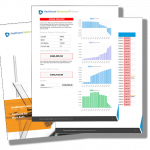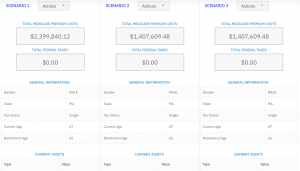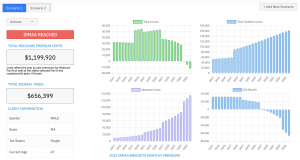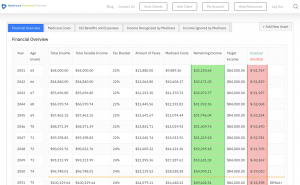Ever felt like you’re trying to decipher a secret code? Welcome to the world of Social Security Medicare Part B. Navigating Social Security Medicare Part B may be as bewildering as a maze, yet it’s essential for your well-being.
Imagine walking into a labyrinth. There are countless turns, dead ends, and hidden doors. Now imagine that this maze is your healthcare journey – sounds scary, right?
What if I said there’s a roadmap exclusively for you? A guidebook filled with wisdom about premiums, deductibles, enrollment periods – everything that makes up the core of Social Security Medicare Part B.
Join me on this journey as we uncover the mysteries of eligibility criteria. We’ll explore how disability benefits or social security retirement impact your coverage. Stick with me and you won’t just lose fear – you’ll gain clarity.
Understanding Social Security Medicare Part B
The complex world of federal health insurance programs can be daunting. Let’s make it easier by exploring one of the crucial elements – Social Security Medicare Part B.
The Four Parts of Medicare
To get a grasp on how all this works, we need to start with an overview. Medicare is divided into four parts: A, B, C and D.
Part A covers hospitalization needs such as skilled nursing or hospice care. It’s like having a safety net for your major medical issues.
Moving on to our main focus here – Part B is the medical insurance component. Think routine doctor visits and preventive services that keep you ticking along nicely. And if there are bumps in the road? Well, things like ambulance services and durable medical equipment also fall under its umbrella.
Who is Eligible for Medicare?
A common question asked about social security medicare part b is ‘who exactly qualifies?’ Age certainly plays a role; those aged 65 or older usually qualify automatically but what about younger folks?
If someone has been receiving disability benefits from either Social Security or the Railroad Retirement Board for at least two years they’re eligible too. Same goes if they have certain diseases such as end-stage renal disease (permanent kidney failure).
It may seem overwhelming but understanding these basics can give you confidence navigating through your health plan options within this country’s leading health insurance program.
Tips:
- You don’t have to navigate alone.
- An informed decision often requires some guidance so consider reaching out to a health insurance expert.
- Be proactive. Managing Medicare benefits is easier when you understand what’s available and how it works for you.
Wrapping it up, making choices from group health plans to sorting out medicare advantage plans is a lot easier when you’re informed. So, take this insight about social security medicare and use it confidently.
Key Takeaway:
Demystifying Social Security Medicare Part B: It’s a crucial part of federal health insurance, covering routine doctor visits and preventive services. Eligibility isn’t just for those aged 65 or older – disability benefits recipients and certain disease sufferers can also qualify. Navigate confidently with expert guidance and proactive understanding.
Enrolling in Social Security Medicare Part B
The journey to enroll in Social Security Medicare Part B can feel like a trip down the rabbit hole. But, don’t fret. We’re here to lend a hand navigating this path.
Initial Enrollment Periods
Your first opportunity to sign up for Medicare Part B is during your Initial Enrollment Period (IEP). The period of initial enrollment commences three months prior to your 65th birthday and concludes after an additional three months. It’s akin to being given the key to open a new chapter of healthcare coverage as you age.
If you decide not to apply during this window because perhaps, you’re still covered under a group health plan from your job or union, fear not. There are other enrollment periods available for those special cases too.
Learn more about when does medicare coverage start?.
Special Enrollment Periods
A Special Enrollment Period (SEP) may seem like finding an oasis in the desert if you missed out on applying during your IEP due various circumstances such as still having insurance through work. The SEP lets individuals who delayed their enrollment because they had group health insurance through employment or union membership enroll without facing penalties.
This little-known secret allows people who didn’t want their benefits at 65 but are now ready, have an avenue back into the system with fewer repercussions. Who knew right? However there’s even more ways one can get enrolled.
Apply online if not ready yet for social security benefits at 65..
Nifty Ways To Enroll In Social Security Medicare Part B
One surprising way you can enroll in Medicare Part B is through automatic enrollment when you start receiving Social Security retirement benefits. This is like a surprise party thrown by the government for your healthcare needs.
If this doesn’t apply to you, another route to take would be applying online if not ready yet for social security benefits at 65. It’s as easy as pie.
Key Takeaway:
Enrolling in Social Security Medicare Part B might feel like a maze, but with guidance and options at your disposal, it doesn’t have to be. From initial enrollment periods around your 65th birthday to special ones for those still covered under group health plans, there are multiple ways to start this new chapter of healthcare coverage. If you miss these windows or don’t fully understand the process, don’t worry. There’s always help available so that nobody gets left behind on their journey towards secure healthcare.
Coverage Details of Social Security Medicare Part B
Medicare, the country’s health insurance program, is divided into several parts. Today we’re focusing on Part B, which helps pay for basic healthcare services. But what exactly does it cover? Let’s take a closer look.
Basic Healthcare Services
The core focus of Medicare Part B is to support you with essential healthcare needs that aren’t hospital-based. It takes care of costs related to outpatient care and preventive services aimed at detecting health conditions early when treatment has the best chance of working effectively.
You can rely on this part of your federal health insurance plan for medical supplies like walkers or wheelchairs deemed medically necessary by your doctor. Need help managing chronic diseases such as diabetes or high blood pressure? You’ve got it. Home healthcare services also fall under its umbrella if prescribed by a physician.
This isn’t all though; more specialized areas are covered too – let me show you how comprehensive it truly is.
- If you need durable medical equipment (DME) – things like oxygen tanks or patient lifts – these come under Part B coverage.
- In case life throws an unexpected curveball in the form of an illness while traveling abroad, some limited emergency foreign travel expenses might be taken care off as well.
- To add icing on the cake: mental health counseling and certain outpatient prescription drugs are included too.
A pretty exhaustive list right there but remember not everything comes free; some co-payments may apply depending upon individual circumstances and specific service details.
Laboratory tests & Imaging studies
It’s not just about the physical, Medicare Part B also covers necessary diagnostic tests. So, if your doctor recommends blood work or a CT scan to diagnose an illness – you’re covered.
Even more specialized procedures like MRI and PET scans are part of the package. Not forgetting X-rays, which we all know can be pretty pricey out-of-pocket.
The best thing? It’s usually right at your fingertips.
Key Takeaway:
Medicare Part B covers a range of non-hospital based health needs, such as outpatient care, preventive services and necessary medical supplies. It also includes home healthcare if prescribed by your doctor. Going on a trip? No worries. Medicare Part B can cover limited emergency expenses overseas too. If you need mental health counseling or certain outpatient prescription drugs, this plan has got you covered. But don’t forget about the co-pay; it’s an essential part of your coverage.
Costs Associated with Social Security Medicare Part B
When planning for health care costs in retirement, understanding the expenses related to Social Security Medicare Part B is essential. Let’s take a look at the premiums, deductibles, and other possible out-of-pocket expenses.
Premiums and How to Pay Them
The standard monthly premium for most people in 2023 is $148.50. But if your income was above a certain amount two years ago (known as IRMAA), you’ll pay more – up to $504.90 per month. The Medicare website provides an easy-to-use table that can help determine your expected premium based on income.
You can choose to pay these premiums in various ways, such as through automatic deductions from social security benefits or federal retiree benefits, direct payments from a checking or savings account, credit card payments, or by mail with check or money order. through automatic deductions from social security benefits or federal retiree benefits; directly from a checking or savings account; by credit card; or by mail with check or money order.
Deductibles and Out-of-Pocket Costs
In addition to paying premiums, keep in mind there’s also an annual deductible of $203 for 2023 before coverage kicks in. After meeting this deductible, you’ll typically pay 20% of the approved amount for most doctor services (including while you’re a hospital patient), outpatient therapy, durable medical equipment such as wheelchairs and walkers.
Beyond that though – brace yourself – because not all medical expenses are covered under Part B. Expenses like routine physical exams (other than “Welcome to Medicare” preventive visit), most prescription drugs taken at home, long-term care like nursing homes unless skilled nursing facility care is needed after a hospital stay, most dental care, and dentures may not be covered. So you might need to pay these costs out of pocket.
Private firms can offer Medigap (Medicare Supplement Insurance) policies to help cover some of the expenses not covered by Original Medicare, such as co-pays, coinsurance and deductibles. This offers a great way to ensure you’re not left out-of-pocket when it comes to your healthcare needs.
Key Takeaway:
Grasping the costs of Social Security Medicare Part B is crucial when planning for retirement. This year, the majority are paying a monthly premium of $148.50. Yet, those with higher incomes might find themselves shelling out up to $504.90 each month. Payment flexibility exists – you can opt for deductions from your benefits or direct payments via bank account or credit card transactions. Don’t forget about the annual deductible which sits at $203.
How Social Security Benefits Interact with Medicare Part B
Enrolling in Medicare is a common occurrence for those already receiving Social Security benefits, but how does it affect your retirement package and financial planning? But what does this mean for your social security retirement package? And how does it impact your financial planning?
Automatic Enrollment for Those Receiving Social Security Benefits
The moment you start to receive social security benefits, the Social Security Administration (SSA) swings into action and automatically enrolls you in both Parts A and B of Medicare. This process typically happens three months before your 65th birthday.
This means if you are on the verge of turning 65 or have just turned 65 and are drawing social security benefits, check out for an envelope from the Department of Health & Human Services (HHS). It contains your red-white-and-blue colored Medicare card.
Your part B coverage starts after four months – which is one month after your birthday. However, if disability benefits come into play things can be different; they’ll affect eligibility as well as when enrollment kicks off.
Moving Forward with Automatic Enrollment
A question arises: “What if I don’t want to get enrolled?” Well. You have options too.
If Part B isn’t needed right away because you’re covered under a group health plan based on current employment status, then follow instructions given by SSA and send back the card to refuse Part B coverage. Remember not responding implies acceptance.
Here’s a fact to note: Your decision can have future coverage implications and may cause delays if you want Part B later due to the Medicare rules about Special Enrollment Periods (SEPs).
Implications on Social Security Benefits
The main interaction between your social security benefits and Medicare Part B comes down to premiums. If you’re already receiving social security, your monthly premium for Part B is deducted directly from your benefit payment.
This makes the payment process much easier, as it is handled automatically. You don’t have to stress about forgetting or missing payments because everything is taken care of automatically.
Key Takeaway:
For those already receiving Social Security benefits, automatic enrollment in Medicare Parts A and B typically starts three months before your 65th birthday. If you have existing group health coverage and don’t need Part B, it’s possible to opt out. But keep this in mind – the choice you make can influence future coverages or even cause delays if you decide that you want Part B down the line.
Special Considerations for Disability Benefits Recipients
If you’re a disability benefits recipient, be aware that there are some distinctions in the enrollment procedure and conditions for Medicare Part B. The process and requirements may differ slightly from those who qualify based on age.
Enrollment for Disability Benefits Recipients
The first thing to understand is when people receiving disability benefits become eligible for Medicare. After 24 months of receiving Social Security or Railroad Retirement Board (RRB) disability benefits, you automatically get enrolled in Parts A and B. It’s crucial not to miss this window as it could impact your health coverage.
You’ll receive a “Welcome to Medicare” package three months before your coverage starts which contains detailed information about the program along with your red, white, and blue Medicare card.
Delaying Part B Enrollment
In some cases, folks might decide they don’t want Part B right away because they already have other insurance through an employer or union. If so, make sure the insurer knows about this decision – it can help avoid unnecessary charges down the line.
To delay enrollment without penalty while still getting disability payments from Social Security or RRB but having group health plan coverage based on current employment status (either yours or family member’s), contact SSA at 1-800-772-1213 TTY: 1-800-325-0778 between Monday – Friday from 8:00 am –7:00 pm all U.S time zones; OR send them written notice asking them not to enroll in Medicare Part B yet due its associated monthly premium costs. But remember if one decides later they want part b again outside open enrollment period special rules apply which will be explained in the next section.
Re-Enrolling in Part B
If you initially declined Medicare Part B, but then decide later that you want it after all, don’t fret. There are Special Enrollment Periods (SEPs) designed just for this scenario.
If your job or union coverage ends, or while you’re still covered, that’s the perfect time to sign up for Medicare Part B. This can be done during a Special Enrollment Period (SEP).
Key Takeaway:
If you’re getting disability benefits, know that after 24 months of payments, you’ll automatically be enrolled in Medicare Parts A and B. Be sure not to miss this. You can delay Part B if needed but make your insurer aware. If later you decide on Part B again, Special Enrollment Periods are there for you.
FAQs in Relation to Social Security Medicare Part B
How much is Medicare Part B with Social Security?
The standard monthly premium for Medicare Part B in 2023 is $170.10, but this can vary based on income.
Is it mandatory to have Medicare Part B?
No, enrolling in Medicare Part B isn’t compulsory. However, not signing up when first eligible could result in penalties later.
Does everyone on Medicare pay Part B?
Yes, those enrolled must cover the cost of premiums unless they qualify for assistance programs that help with these payments.
Is Medicare Part B taken out of Social Security check?
If you receive social security benefits, your part b premium will typically be deducted directly from your benefit payment each month.
Conclusion
Stepping into the world of Social Security Medicare Part B can feel like walking a maze. But, with this guidebook in hand, you’ve navigated its twists and turns.
You now understand how Medicare is divided – from hospitalization to prescription medications. You’ve learned who qualifies for coverage based on age or disability status.
Digging deeper, you explored enrollment periods and special circumstances that let folks join outside regular timelines. You also uncovered the types of services covered under this part of the program.
Awareness about premiums, deductibles and other costs associated has grown. Now you know more about how Social Security benefits interact with your health plan.
In short: Don’t fear complexity – embrace it! With knowledge comes power; use yours wisely!
Table of Contents:
- Understanding Social Security Medicare Part B
- Enrolling in Social Security Medicare Part B
- Coverage Details of Social Security Medicare Part B
- Costs Associated with Social Security Medicare Part B
- How Social Security Benefits Interact with Medicare Part B
- Special Considerations for Disability Benefits Recipients
- FAQs in Relation to Social Security Medicare Part B
- Conclusion
Streamlining the Medicare Surcharge Calculation Process.
Our Healthcare Retirement Planner software is designed to streamline the retirement planning process for financial professionals. By providing an efficient way to calculate IRMAA costs, our tool helps you save time and focus on other aspects of your clients’ retirement plans.
- Faster calculations: Our software quickly calculates IRMAA costs based on your client’s income and tax filing status, eliminating manual calculations and potential errors.
- User-friendly interface: The intuitive design of our platform makes it easy for financial professionals to input data and generate results with minimal effort.
- Data integration: Seamlessly integrate our calculator into your existing financial planning tools or CRM systems for a more streamlined workflow.
- Easy to Understand Reports: Export reports to easily share with your clients
- Tax and Surcharge Modeling: see how different types of income affects both taxes and your surcharges.
In addition to simplifying the calculation process, using our Healthcare Retirement Planner can also help improve communication between you and your clients. With clear visuals that illustrate how IRMAA costs impact their overall retirement plan, you can effectively convey complex information in an easily digestible format. This enables clients to make informed decisions about their healthcare expenses during retirement while ensuring they are prepared for any potential changes in Medicare premiums due to income fluctuations. To learn more about how our software can benefit both you as a financial professional and your clients’ retirement planning experience, visit the features page. Streamlining retirement planning processes can help financial professionals save time and resources, allowing them to focus on other areas of their clients’ needs. Automated calculation of IRMAA costs is the next step in streamlining this process even further.





